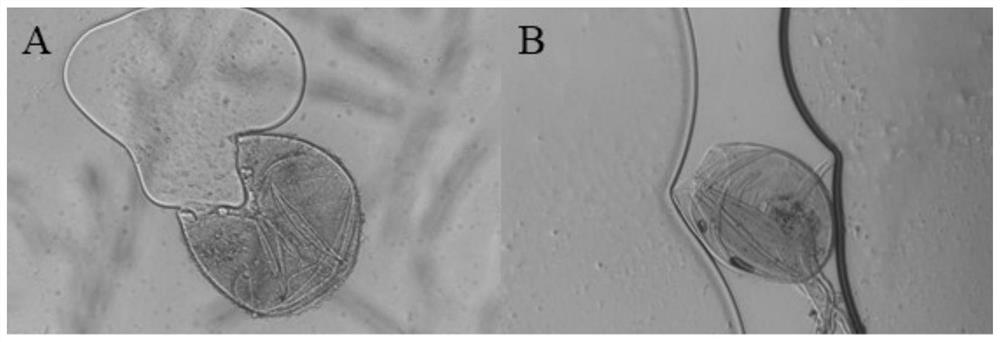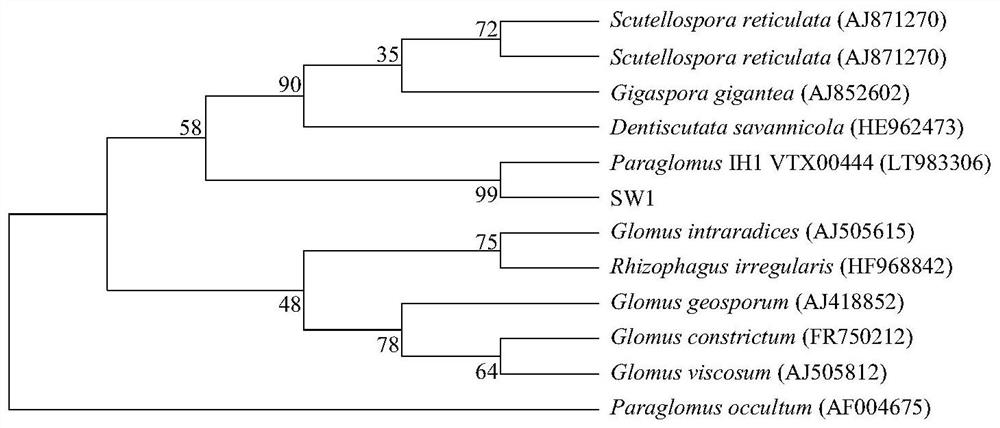A mycorrhizal fungus of the genus Glomus and its application in the cultivation of rootstocks resistant to apple cropping obstacles
The technology of glomus fungus and mycorrhizal fungus is applied in the field of agricultural microorganisms to achieve the effects of fast root growth, improved cultivation efficiency and alleviation of obstacles to continuous cropping of apples.
- Summary
- Abstract
- Description
- Claims
- Application Information
AI Technical Summary
Problems solved by technology
Method used
Image
Examples
Embodiment 1
[0034] Example 1: Screening of efficient dominant strains
[0035] Collect soil samples from apple rhizosphere in Wantou Village, Shahe Town, Laizhou, quickly freeze and bring them back, and send them to Meiji Biotech for high-throughput sequencing. The local arbuscular mycorrhizae are directly screened from the apple rhizosphere soil through the second-generation high-throughput sequencing technology Fungal dominant species, such as figure 1 , at the genus level ( figure 1 A) and species level ( figure 1 B) All show that the dominant bacteria in the soil sample is Paraglomus sp.
Embodiment 2
[0036] Embodiment 2: Isolation and identification of high-efficiency dominant strain
[0037] 1. Collect soil samples of the rhizosphere of Apple genus in Wantou Village, Shahe Town, Laizhou.
[0038] 2. Mix the collected soil samples with sterilized river sand at a weight ratio of 1:1, put them in pots, and divide them into three parts. The first part is sown with corn, the second part with clover, and the third part with Pingyi sweet tea seedlings ( 3 replicates each), carry out enrichment culture to the dominant bacteria of the genus Glomus, and after 4 months of cultivation in the greenhouse, mix three parts of the soil of sowing corn, clover and Pingyi sweet tea seedlings to prepare the bacterium of the genus Glomus. Isolation of dominant bacteria.
[0039] 3. Take 20g of soil sample from the mixed soil, put it in a 1L beaker, add 500mL of sterile water, stir evenly, and pass through 50 mesh and 400 mesh sampling sieves successively. Transfer all the residue on the 400-...
Embodiment 3
[0050] Embodiment 3: the preparation of SW1 bacterial agent
[0051] The SW1 strain was inoculated on the roots of clover that had grown for one week, and single-spore culture was carried out in the greenhouse for one month, and further multiplied, and the roots of the clover were crushed to obtain a powder containing SW1.
[0052] Mix the sterilized substrate (common seedling substrate, which can be obtained through commercial channels) and the powder containing SW1 at a mass ratio of 3:1, sow clover, and expand the propagation in the greenhouse and potted conditions. Three months later, the infection rate was detected, the shoots were removed, and the roots of the clover were crushed together with the substrate to obtain the SW1 inoculum for subsequent experiments, air-dried in a cool place, and stored at 4°C.
PUM
 Login to View More
Login to View More Abstract
Description
Claims
Application Information
 Login to View More
Login to View More - R&D
- Intellectual Property
- Life Sciences
- Materials
- Tech Scout
- Unparalleled Data Quality
- Higher Quality Content
- 60% Fewer Hallucinations
Browse by: Latest US Patents, China's latest patents, Technical Efficacy Thesaurus, Application Domain, Technology Topic, Popular Technical Reports.
© 2025 PatSnap. All rights reserved.Legal|Privacy policy|Modern Slavery Act Transparency Statement|Sitemap|About US| Contact US: help@patsnap.com



